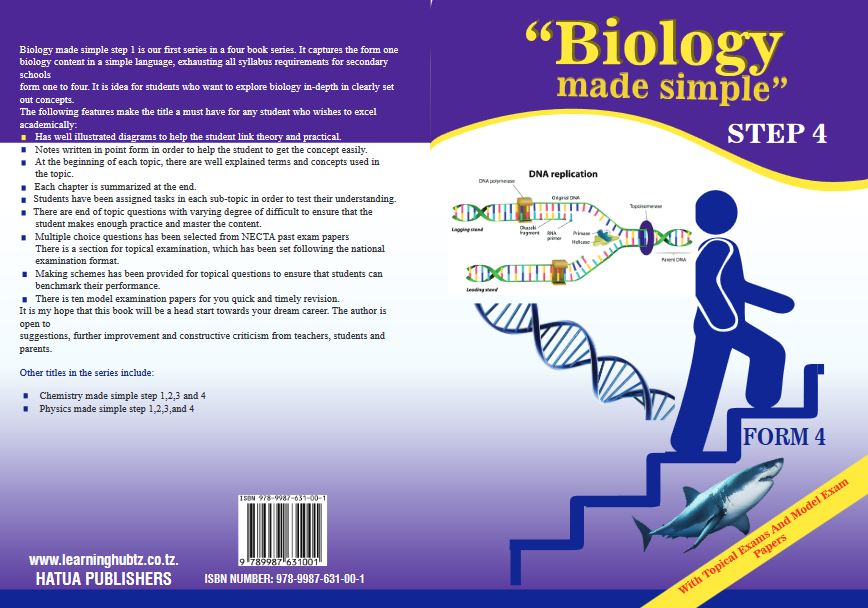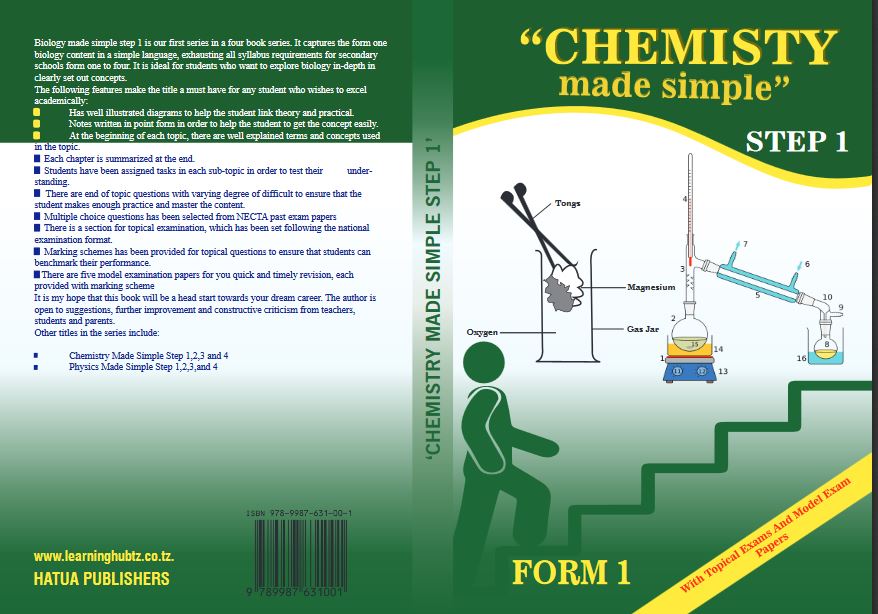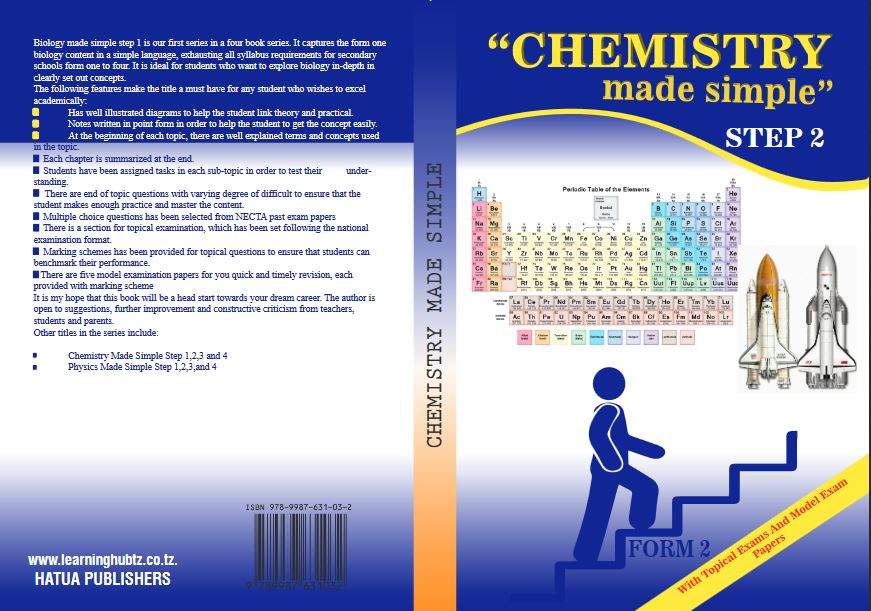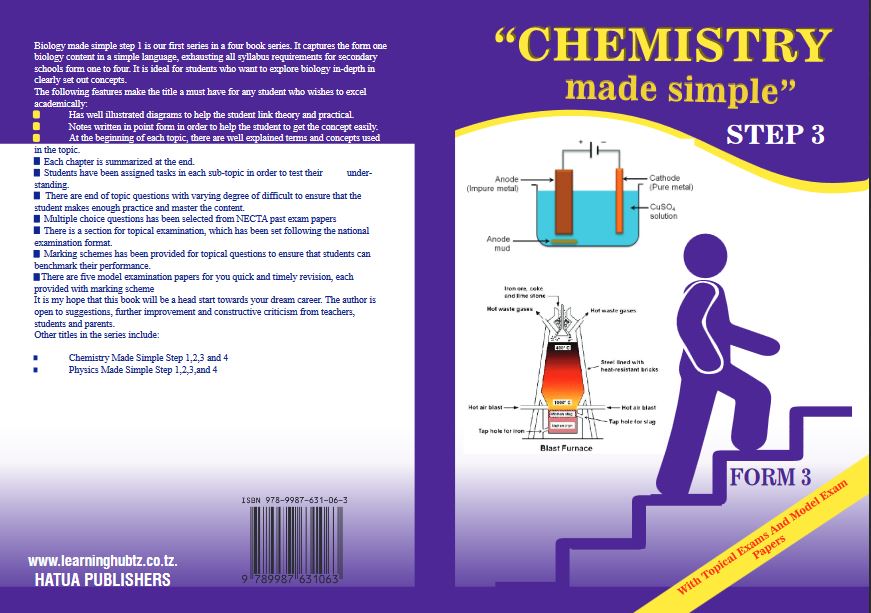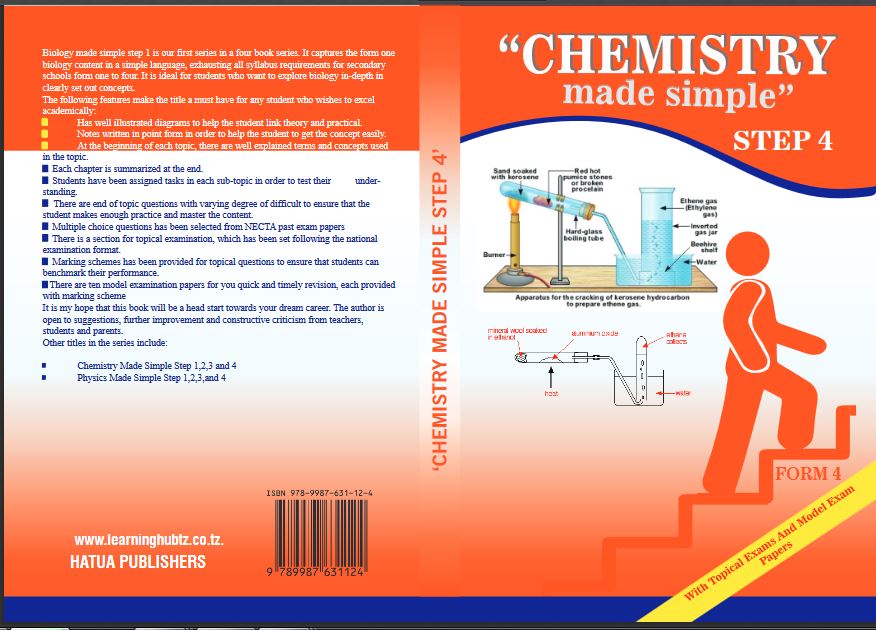

FORM THREE BIOLOGY EXAM SERIES 230
FORM THREE BIOLOGY EXAM SERIES 230
THE PRESIDENT’S OFFICE
REGIONAL ADMINISTRATION AND LOCAL GOVERNMENT
FORM THREE ANNUAL EXAMINATION
BIOLOGY
TIME: 3 HOURS NOVEMBER 2024
Instructions
1. This paper consists of sections A, B and C with a total of ten (10) questions.
2. Answer all questions. All answers must be written in the spaces provided.
3. Section A and C carry fifteen (15) marks each and section B carries seventy (70) marks.
4. All writings must be in blue or black ink except drawing which must be in pencil. 5. All communication devices, calculators and any unauthorized materials are not allowed in the Mock Assessment room.
6. Write your Mock Assessment Number at the top right corner of every page.
SECTION A (15 Marks)
Answer all questions in this section.
1. For each of the items (i)-(x), choose the correct answer from among given alternative and write its latter in booklet given.
i. Nyerere observed using a microscope an organism moving by help of Pseudopodia. This organism is likely to be
A. Amoeba
B. Euglena
C. Paramecium
D. Plasmodium E. Spirogyra ii. A problem of hiccup can be solved by
A. Drinking enough amount of water
B Eating enough food
C. Reducing amount of carbondioxide
D. Swallowing large amount of air E. Taking small amount of water
iii. In order to maintain proper health to individual the following factors should be practical except
A. Have time for break and leisure
B. Practical regular physical exercise
C. Reduce unhealthy food intake
D. Sleep in well-ventilated room E. Take medical drugs regularly
iv. What happens to blood cell when put into a solution which higher concentration of glucose?
A. Glucose enter blood cells from glucose solution
B. Glucose leave the glucose solution into blood cells
C. Water and glucose leave blood cells at equal rates
D. Water enters the blood cell form glucose solution
E. Water leave the blood cell into glucose solution
v. A cross-section ally cut stem was immersed in Iodine solution for five minutes and appeared to have a blue black colour. Which part of the stem stained blue black?
A. Cambium
B. Endodermis
C. Pericycle D. Phloem vi. Identify one adaptation of human respiratory system in its role
A. Has a nostril that allow passage of gases
B. Has cilia for trapping dust and germs
C. Has hairs for capturing micro-organism
D. It is moist to allow mucus secretion E. Produces mucus to warm entering hair
vii. During a camping trip, a friend experience an insect bite with mild swelling and redness which component of first Aid would you be most beneficial for initial relief
A. Anti-histamine cream
B. Instant cold pack
C. Alcohol wipe
D. Elastic Bandage
E. Triangular Bandage
viii. An organelle found both plant and animals cell known as power house of cell for energy generation from food molecule is
A. Vacuole
B. Golgi
C. Cell-wall
D. Mitochondria E. Chloroplast ix. Which of the following is the end product of starch digestion in duodenum.
A. Glucose
B. Amine Acid
C. Fats
D. Maltose
E. Peptide
x. All things around an organism makes up its
A. Ecosystem
B. Abiotic Component
C. Biotic component
D. Niche
E. Natural environment
2. Match the items in LIST A with correct response in LIST B by writing its letter below item number.
| LIST A | LIST B |
| i. Structure for gaseous exchange in humans ii. Structure which trap dust in Trachea iii. Structure which protect lungs from injury iv. Process which release energy in absence of oxygen v. Organism which break down sugar to carbon dioxide and alcohol vi. Accumulated of lactic acid in muscles | A. Anaerobes B. Aerobic respiration C. Anaerobic respiration D. Ribs E. Larynx F. Cilia G. Bronchiole H. Alveoli I. Yeast J. Oxygen debt |
SECTION B 70 marks
Answer all questions
3. a) Identify the organism which are used for gaseous exchange for the following organism i. Cow ii. Frog iii. Maize leaf iv. Fish
v. Earth worm
b) The figure below shows experimental set-up to investigate various aspect of gaseous exchange.

Answer the following questions
i. What aspect of gaseous exchange is experiment designed to investigate?
ii. Explain function of Lime water iii. Explain why Lime water in test tube B turned Milky iv. Explain why there was no change in test tube A v. Describe the term gaseous exchange
4. i) Explain why people urinate frequently after taking alcohol ii) Determine the pathway of water reabsorption in nephrons and determine hormone affected by alcohol
5. a) State three actions which take place in human body in response to each of the following
i. When temperature of surrounding is low ii. When body temperature rise due to increase in surrounding temperature
b) Briefly explain why people look pale when they fell cold
6. a) Explain two significance of reproduction
b) Explain why it is not possible for insect to visit and pollinate wind pollinated flower
7. a) Plant dispersed its seeds Naturally. The seedling formed were examined two weeks later. They were found is differ in height. Suggest three environment factor which caused the difference.
b) Explain factors that may hinder fertilization in humans
8. Digestion of food materials in the Ileum produces end product by help of various enzymes. Justify
SECTION C (30 MARKS)
Answer any two questions
9. a) Mr. Juma a biology teacher at Kibuzu secondary school put a piece of bread on a wet cup board after a few days certain gray substance were observed to grow on a piece of bread .
i. Name the organism that grow on bread surface ii. Name the kingdom in which the observed organism belongs iii. List any three advantage of Kingdom to which the organism named above belong.
b) Animals are considered to be Heterotrophs while plants are said to be autotrophs
i. Name the process that make plants to be called autotrophs ii. Write chemical equation for process above iii. What will happen if the process does occurs in environment?
10. Most women prefer bottle breast feeding currently. Advice them on advantage of breast feeding.
11. On his way home, Mohammed heard a loud voice of lion. Describe the mechanism which enabled James is hear the voice.
FORM THREE BIOLOGY EXAM SERIES 189
FORM THREE BIOLOGY EXAM SERIES 189
PRESENT’S OFFICE, REGIONAL ADMINISTRATION AND LOCAL GOVERNMENT
SECONDARY EXAMINATION SERIES
COMPETENCY BASED EXAMS
BIOLOGY FORM THREE
ANNUAL EXAMINATIONS- 2023
TIME: 2:30 HRS
INSTRUCTIONS
- This paper consists of section A, B and C with a total of eleven (11) questions
- Answer all questions in section A and B and two (2) questions from section C.
- Section A carries sixteen (16) marks, section B carries fifty four (54) marks and section C carries thirty (30) marks.
- All writings must be in blue or black ink except drawings which should be in pencil.
- All communication devices, programmable calculators and any unauthorized materials are not allowed in examination room.
- Write your examination number on every page of your answer sheet(s).
SECTION A (16 MARKS)
1. For each of the following items (i) – (x) Choose the most correct answer correct answer from among given alternatives given.
- After visiting Tarangire National parks, Peter saw organism which had similar feeding habit. What term can be used to describe this organism?
- Community
- Trophic level
- Food chain
- Food web
- Habitat
- Monica found an Organism shaped like an umbrella in a damping site. Which statement is true about the organisms?
- It is a mushroom and belongs to phylum Ascomycota
- It is yeast and belongs to phylum Basidiomycota
- It is mushroom and belongs to phylum Basidiomycota
- It is Mucor and belongs to phylum Ascomycota
- It is Yeast and belongs to phylum Ascomycota.
- David, A bus driver was preparing items for his first Aid Kit Which one did she not include?
- A pair of scissors
- Touch
- Sterilized cotton wool
- Amoxylin Tablets
- Juma ate a meal consisting of protein. Where did the digestion of the meal begum?
- Mouth
- Duodenum
- Stomach
- Small intestine
- Ileum
- During an investigation a form II student put a piece of bread in a wet cupboard, after a few days the bread was covered with grayish substance. What are the name of the substance?
- Penicillium
- Rhizopus stononifer
- Entamoeba histolytic
- Agaricus compestris
- Saccharomyces cerevisiae
- In a motor car accident the bus driver found that he could hardly maintain equilibrium, which of the structure was damaged?
- Semi-circular canal
- Fore brain
- Medulla Oblangata
- Eustachian Tube
- The cochlea
- Dr. Nambena received medical results from laboratory and identified that the victim suffered from filicidal woman infection. Which of the following disease is typical caused by above worms?
- Lymphloma
- Elephantiasin
- Oedema
- Thrombosis
- Arteriosclerosis
- The glomenulars filtrate contains the following materials
- Glucose molecules, water, urea and dissolved mineral salt
- Cells, protein and glucose
- Uric acid, proteins and urea
- Vitamin, urea and water
- Mineral salts, proteins and glucose
- The part of ear which convert sound signals into nerve impulse which are transmitted to brain include
- Ear Ossicles
- Semicircular canal
- Cochlea
- Eustachian Tube
- Ear dram
- The part of compound Microscope which help to concentrate light into beams to
- Ocular tube
- Condenser
- Mirror
- Revolving nosepiece
- Diaphragm
- Match items from LIST A with correct phrase in LIST B by writing the letter of correct response from LIST B against item number in LIST A.
| LIST A | LIST B |
|
|
SECTION B (54 MARKS)
Answer all questions in this section
3. (a)Give three factors that Aid in Ultra filtration in the glomenulars
(b)Give explanation of the following
- Plasma proteins are absent in glomerular filtrate
- Urine of a normal person does not have glucose
- During cold days one produces large quantities of dilute Urine
(c) State 3 adaptation of convoluted tubule to re-absorption
- (a)Sate any three adaptations of the leaf to photosynthesis
(b)How do the following factors affect rate of photosynthesis
- Chlorophyll
- Sunlight
- Carbon dioxide
- (a) During cooking a cook unfortunately touched a hot charcoal burner. He pulled in hand abruptly.
- What is the name of that response
- What is the name given to pathway which describe response in 8a(i) above
(b) Illustrate the pathway of an impulse from the sense organs to effectors of the cooks’ hand
- Juma visited Mikumi National park and saw the following organisms, Zebra, giraffe, lion grasses, Mushroom, hyena and antelope.
- Construct two (2) food chains from organism observed in the National park
- Construct a simple food web
- Identify organism which are
- Producer
- Secondary consumer
- Decomposer
- (a)Draw a diagram of maize cell and label the parts responsible for the following functions.
- Control all activities of cell
- Provide shape of the cell
- Chemical reaction occur here
(b)How is maize cell different from cell of a goat?
- (a)A flower was found to have conspicuous petals scented and firmly held stigma and anthers
- What is likely agent of pollination of the flower?
- What is the significance of firm held stigma in the flower?
(b)Briefly explain the rule the following structures in flowers
- Petal
- Stigma
- Ovary
- Style
- Anther
SECTION C (30 MARKS)
Answer two (2) questions in this section
- (a)Explain why
- The rate of breathing increase quickly during exercise
- Is better to breathe through nose than through mouth
(b)How are respiratory surface adapted to their role?
- Many people believe that fungi are harmful organism. As biologist, explain six ways in which fungi are beneficial to humans
- Humans in their daily life come into contamination with viruses, bacteria, worms, and other pathogens explain any six ways used by humans to prevent invasion and infections by disease causing micro-organisms.
FORM THREE BIOLOGY EXAM SERIES 153
FORM THREE BIOLOGY EXAM SERIES 153
THE PRESIDENT’S OFFICE MINISTRY OF EDUCATION, REGIONAL ADMINISTRATION AND LOCAL GOVERNMENT
COMPETENCY BASED SECONDARY EXAMINATION SERIES
BIOLOGYFORM THREE
TIME: 3 HOURSNOVEMBER 2022
INSTRUCTIONS:
- This paper consists of sections A, B and C.
- Answer All questions in section A, B and two (2) question from section C, question (13) is compulsory.
- Write your Examination Number on every page of your answer booklet(s).
SECTION A (15 MARKS)
- Choose the correct answer
- Disease which spread quickly and affect the large number of people for a short time is:
- Pandemic disease
- Endemic disease
- Epidermic disease
- AIDS
- Typhoid
- On the microscope the STAGE is a part which:
- Direct the light to the object under observation
- Hold the object to be observed
- Move fine adjustment knob so as to obtain a clear mage of the object
- Magnify the object under observation
- Support the objective lens
- Which of the following are hormone concerned with regulation of sugar in the blood
- Adrenaline hormone, thyroxine hormone
- Auxins hormone and insulin hormone
- Prolaction, oxytocin
- Insulin, glucagon
- Oestrogen, progesterone
- Oxygenated blood is found in arteries except:
- Aorta
- Subclaria artery
- Pulmonary artery
- Pulmonary vein
- Vein
- When a bird builds a nest on a tree, the bird benefits but the tree neither benefits nor loses. What type of relationship is shown by bird and the tree?
- Amensalism
- Parasitism
- Mutualism
- neutralism
- Commensalism
- The word cell is derived from the Latic word “cellula” which means a:
- Unit of life
- Little room
- Cork from the bark of the tree
- Living thing
- Robert Hook
- Organisms can either be:
- Unicellular or Prokaryote
- Living thing or Eukaryote
- Living thing or Non-living thing
- Multicellular or Unicellular
- Multicellulalr or Unicellular
- Pick up the wrong statement
- All organisms respire
- Some fungi are edible
- Protoctista have photosynthetic and heterotrophic mode of nutrition
- Cell wall is absent in Animalia
- Nuclear membrane is absent in Animalia
- One of the major component of the cell was of most fungi is:
- Chitin
- Cellulose
- Starch
- Lipids
- Phospholipid bilayer
- Group of sporangia borne on the underside of fern leaves are called:
- Tholus
- Protholus
- Fronds
- Fiddle head
- Sori
2.
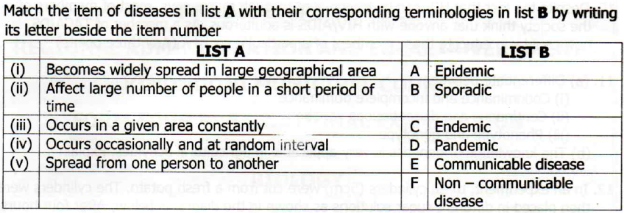
SECTION B:
- (a)Define the following terms as used in Biology
(i)An accident
(ii)Burning
(iii)Safety
(iv)First aid kit
(b)Explain shortly why is important to dispose waste properly
- It has been observed that some people dispose waste around the lake which supply water to the surrounding community. Briefly explain three problems which are likely to happen to the area.
- Study carefully the following food chain then answer the questions that follow:
![]()
![]()
![]() Maize seedsHensHumansBacteria
Maize seedsHensHumansBacteria
(a)Which of the above organisms are:
(i)Herbivores(ii)Consumers
(b)(i)Name other organisms that can replace the bacteria from the food chain in5 above
(ii)Outline two advantages of food chain
- Alex complain of having burning sensation around the chest region
(a)What digestive order is the facing?
(b)Give three measures he should take to treat the disorder
- (a)What is the difference between first aid and first aid kit?
(b)Outline five (5) importance of first aid to a victim
- (a)Differentiate between responsible behaviour and risky behavior
(b)State two behaviors which may lead to the following risks
(i)STD’s
(ii)HIV infections
(iii)Drug abuse
(iv)Unplanned pregnancies
(c) Suggest two (2) ways on how to care and support a victim of HIV/AIDS.
- Explain how a plant cell prevent bursting when placed in hypotonic solution
(b) What will be the effect in recipient's blood when he/she has been transfused an incompatible blood from the donor.
(c) State any three precautions to be taken during blood transfusion
- Consider that you are medical doctor and you have received a patient whose investigation a diagnosed kidney stone. Suggest to the patient three possible causes and three control measures for kidney stones.
- Reptiles are organisms whose body temperature is affected by environmental temperature. Briefly explain two ways that help reptiles to survive in different weather condition.
- Briefly explain four reasons why plants lack specialized excretory organs
- Explain the biological significance of the following ;
(i) Stomata are placed in the lower part of the leaf
(ii) Plants shed off leaves during dry seasons
(iii) It is advised to irrigate your plants in early morning or late evening.
(iv) Alveoli is supplied with a network of blood capillaries
SECTION C
Answer two questions from this section, question number 13 is compulsory
- Briefly explain the HIV/AIDS basing on the following guidelines
- Meaning
- Mode of transmission
- Symptoms
- Preventive measures
- Effects
- Treatment/cure
- Which classification system do taxonomists mostly prefer? Explain any four reasons as to why they prefer that system.
- Discuss the economic importance of bacteria. Give examples where necessary
FORM THREE BIOLOGY EXAM SERIES 109
FORM THREE BIOLOGY EXAM SERIES 109
THE PRESIDENT’S OFFICE
MINISTRY OF EDUCATION, REGIONAL ADMINISTRATION AND LOCAL GOVERNMENT
SECONDARY EXAMINATION SERIES
BIOLOGY ANNUAL EXAMINATION
FORM THREE-NOVEMBER 2021
(For both School and Private Candidates)
CODE 033/1
TIME: 3:00 HOURS ___________________________________________________________
INSTRUCTIONS:
- This paper consists of sections A, B and C.
- Answer All questions in section A, B and two (2) question from section C, question (13) is compulsory.
- Write your Examination Number on every page of your answer booklet(s).
SECTION A (15 MARKS)
- Choose the correct answer
(i) Disease which spread quickly and affect the large number of people for a short time is:
A: Pandemic disease B: Endemic disease
C: Epidermic disease D: AIDS
E: Typhoid
(ii) On the microscope the STAGE is a part which:
A: Direct the light to the object under observation
B: Hold the object to be observed
C: Move fine adjustment knob so as to obtain a clear mage of the object
D: Magnify the object under observation
E: Support the objective lens
(iii) Which of the following are hormone concerned with regulation of sugar
in the blood
A: Adrenaline hormone, thyroxine hormone
B: Auxins hormone and insulin hormone
C: Prolaction, oxytocin
D: Insulin, glucagon
E: Oestrogen, progesterone
(iv) Oxygenated blood is found in arteries except:
A: Aorta B: Subclaria artery
C: Pulmonary artery D: Pulmonary vein
E: Vein
(v) Blood group in genetics is an example of:
A: Dominance B: Continuous variation
C: Gametogenesis D: Epistosis
E: Discontinuous variation
(vi) The word cell is derived from the Latic word “cellula” which means a:
A: Unit of life B: Little room
C: Cork from the bark of the tree D: Living thing
E: Robert Hook
(vii) Organisms can either be:
A: Unicellular or Prokaryote B: Living thing or Eukaryote
C: Living thing or Non-living thing D: Multicellular or Unicellular
E: Multicellulalr or Unicellular
(viii) Pick up the wrong statement
A: All organisms respire
B: Some fungi are edible
C: Protoctista have photosynthetic and heterotrophic mode of nutrition
D: Cell wall is absent in Animalia
E: Nuclear membrane is absent in Animalia
(ix) One of the major component of the cell was of most fungi is:
A: Chitin B: Cellulose C: Starch
D: Lipids E: Phospholipid bilayer
(x) Group of sporangia borne on the underside of fern leaves are called:
A: Tholus B: Protholus C: Fronds
D: Fiddle head E: Sori
2. Match the functions of components of the skeleton in List A with their corresponding components of the skeleton in List B by writing the letter of the correct response beside the item number in the answer booklet provided.
| LIST A | LIST B |
|
|
SECTION B:
- (a) Define the following terms as used in Biology
(i) An accident
(ii) Burning
(iii) Safety
(iv) First aid kit
(b) Explain shortly why is important to dispose waste properly
- It has been observed that some people dispose waste around the lake which supply water to the surrounding community. Briefly explain three problems which are likely to happen to the area.
- Study carefully the following food chain then answer the questions that follow:
![]()
(a) Which of the above organisms are:
(i) Herbivores (ii) Consumers
(b) (i) Name other organisms that can replace the bacteria from the food chain in 5 above
(ii) Outline two advantages of food chain
- Alex complain of having burning sensation around the chest region
(a) What digestive order is the facing?
(b) Give three measure he should take to treat the disorder
- (a) What is the difference between first aid and first aid kit?
(b) Outline five (5) importance of first aid to a victim
- (a) Differentiate between responsible behaviour and risky behavior
(b) State two behaviors which may lead to the following risks
(i) STD’s
(ii) HIV infections
(iii) Drug abuse
(iv) Unplanned pregnancies
(c) Suggest two (2) ways on how to care and support a victim of HIV/AIDS.
8. (a) List any four macro-elements in plant nutrition.
(b) Explain the causes of any three common disorders and diseases of the human digestive system.
- Consider that you are medical doctor and you have received a patient whose investigation a diagnosed kidney stone.
Suggest to the patient three possible causes and three control measures for kidney stones.
- Reptiles are organisms whose body temperature is affected by environmental temperature. Briefly explain two ways that help reptiles to survive in different weather condition.
12. (a) Briefly explain three importance of movement in plants and animals.
(b) State any five functions of the skeleton.
SECTION C
Answer two questions from this section, question number 13 is compulsory
- Briefly explain the HIV/AIDS basing on the following guidelines
- Meaning
- Mode of transmission
- Symptoms
- Preventive measures
- Effects
- Treatment/cure
14. (a) (i) List the five kingdoms into which organisms are placed.
(ii) List the distinctive features of members of the kingdom to which a malaria vector belongs.
FORM THREE BIOLOGY EXAM SERIES 66
FORM THREE BIOLOGY EXAM SERIES 66
PRESIDENT'S OFFICE
REGIONAL ADMINISTRATION AND LOCAL GOVERNMENT
ANNUAL EXAMINATION
BIOLOGY F3- FORM THREE
NAME………………………………………..CLASS……………………………TIME: 3HRS
INSTRUCTIONS:-
- This paper consists of sections A, B and C
- Answer all questions
- All answers must be written in the spaces provided
- All writings should be in blue/black inks except for drawings that should be in pencils
SECTION A (15 Marks)
Answer all questions in this section
- Multiple choice questions. Choose the best answer in each case and write down its letter beside the question.
- The rate of photosynthesis is greatly influenced by the following factors except;
- Temperature
- Water
- Soil fertility
- Carbondioxide
- Light intensity
- How many gametes are produced from one cell during meiosis;
- Two B. Four C. Six D. Eight D. Ten
- Which of the following is not an excretory product in plants;
- Tannis
- Carbondioxide
- Urea
- Calcium oxalate
- Latex
- Which of the following organism belong to phylum protozoa;
- Mushroom
- Spirogyra
- Funaria
- Tick
- Amoeba
- One of the following is not part of the reproduction system of a female mammals;
- Uterus
- Urethra
- Oviduct
- Vagina
- Ovary
- Which of the following is the most important basic difference between plants and animals;
- Growth
- Locomotion
- Nutrition
- Irritability
- Excretion
- The part of a brain responsible for reasoning and imagination is known as;
- Spinal cord
- Medulla Oblongata
- Cerebrum
- Cerebellum
- Brain chamber
- By which process does Carbondioxide pass from the blood to alveoli of the lungs;
- Osmosis
- Oxidation
- Transpiration
- Diffusion
- Respiration
- In which category malpighian layer of mammalian skin is placed?
- Tissue
- Organ
- Cell
- System
- Organism
- A group of animals that maintain the body temperature at more or less constant is;
- Regulators
- Cold blood animals
- Warm blood animals
- Poikilotherm
- Homoeotherms
- Matching item questions. Match the items in List A with the correct responses in List B by writing the letter of the correct responses beside the item number.
| LIST A | LIST B |
|
|
SECTION B: 60 MARKS
Answer ALL questions in this section
- (a) Define each of the following;
- First Aid
- Recycling
- Waste
(b) What is the most productive way of recycling garden and kitchen organic matter?
(c) Give two (2) important of First Aid.
- (a) i. What is a reflex action
ii.Give four examples of reflex actions.
iii. Explain the importance of reflex actions to animals.
(b) i.State two difference between nervous control and hormonal control.
ii. State the components of the central nervous system.
- (a) Explain the meaning of the following terms;
- Transportation of materials
- Mass flow
(b) Explain what would happen when a plant cell is placed in hypertonic solution.
- (a) i. The kingdom plantae is divided into different divisions. Mention them.
ii. Give one examples of the plants which are found in each division.
(b) i. Identify structures found in plant cell only.
ii. Describe the functions of each structure identified in (b) (i) above.
- Study the diagram below which shows a part of the human uniferous tubule then answer the questions that follow;
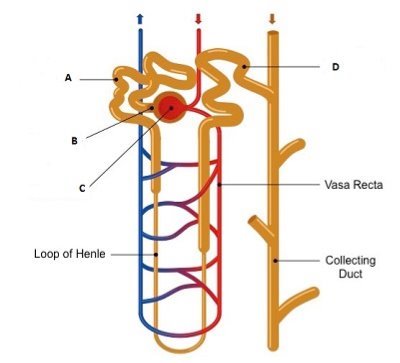
(a)i. Name the parts labeled A, B and D.
ii. What is the name given to fluid labelled C?
- Name two (2) components of blood that will not diffuse into the part labeled C.
- Name a nitrogenous waste which is present in urine but absent in the part labelled B.
(b)List the process involved in urine formation.
- (a) State three factors affecting gaseous exchange in animals.
(b) Why tadpoles dies when taken out of water to the land.
- (a) i. Identify two common features present in a villus and alveolus.
ii. Mention the roles played by the villus and alveolus respectively.
(b) What are the respiratory surfaces for each of the following organisms?
i. Amoeba
ii. Fish
iii. Grasshopper
iv. Rose plant
- (a) Define the following terms as used in reproduction;
- Fertilization
- Ovulation
(b) Name and explain how two types of twins occur.
11.(a) Explain the meaning of the following ecological terms;
(i)Food chain(ii) Trophic level
![]()
![]()
![]()
![]() (b) GrassMouseSnakeHawkBacteria
(b) GrassMouseSnakeHawkBacteria
From the above chain identify the organ which is;
(i)A primary producer
(ii)A tertiary consumer
(iii)Herbivores
(iv)Carnivores
(v)What is a role of bacteria in the chain above
12. (i) What is classification?
(ii) State three distinctive features of the kingdom plantae
(iii) What is meant by the term “Sporophyte”.
(iv) With one example each list six phylum belong to the kingdom protoctista.
SECTION C: 20 MARKS
Answer ONLY ONE (1) questions from this section.
14. Write an essay on pollination in plants under the following headings;
(a)Meaning of pollination
(b)Types of pollination
(c)Agent of pollination
(d)Characteristics of wind pollinated (4 point) and insect pollinated flowers (4 points).
15. Discuss the economic importance of fungi. Give examples where necessary.
FORM THREE BIOLOGY EXAM SERIES 34
FORM THREE BIOLOGY EXAM SERIES 34
Hub App
 For Call,Sms&WhatsApp: 255769929722 / 255754805256
For Call,Sms&WhatsApp: 255769929722 / 255754805256
 For Call,Sms&WhatsApp: 255769929722 / 255754805256
For Call,Sms&WhatsApp: 255769929722 / 255754805256



